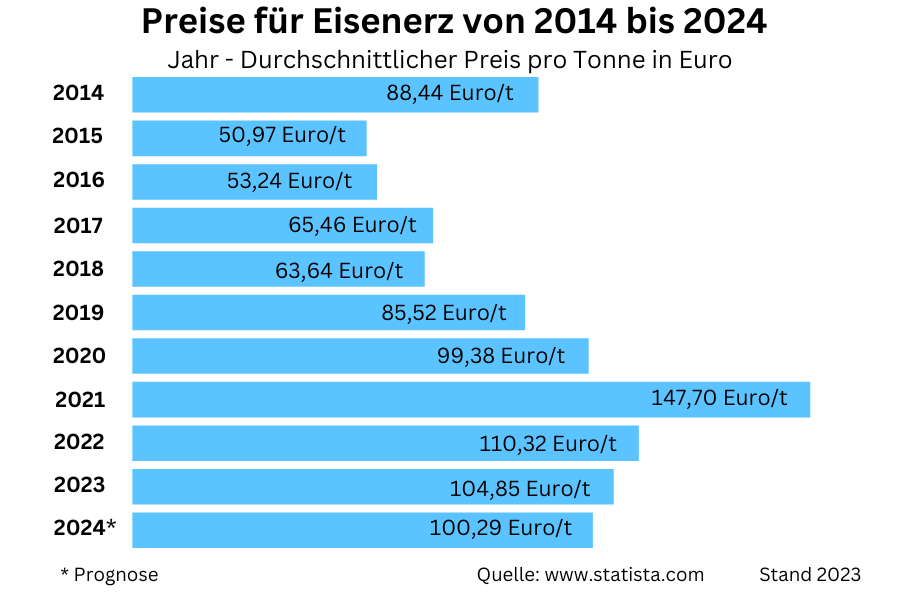What do you currently get for a kilo of scrap iron or steel?

Depending on the type of iron scrap, the price per kilo is between 10 and 40 cents. Steel is a mixture of iron and carbon and is therefore also considered iron scrap. For stainless steel please see our subpage Stainless steel prices at.
Current scrap prices for iron and steel
| Art | Average price per kilo in euros |
|---|---|
| E1 - iron and steel, mixed scrap | 0.22–0.24 euros/kg* |
| E3 - Heavy scrap | 0.29–0.34 euros/kg* |
* Prices depend on quantity and location. There is a possibility that larger quantities can potentially achieve higher prices.
Is it worth selling iron and steel scrap?
Since the production of new steel requires twice as much energy as the reprocessing of used material, over 90 percent of steel scrap is recycled. Every ton of recycled iron saves around 1.7 tons of climate-damaging CO2.
Therefore, your scrap iron or steel is worth cash to the scrap dealer. Especially if you want to sell larger quantities of scrap iron, it's worth going to a scrap buyer.
Overview of the different categories in the iron and steel scrap trade
Mixed scrap made of iron and steel (light scrap)
This category includes both iron parts and steel parts with a wall thickness of up to 5 millimeters. This group includes, among other things, typical household scrap, steel barrels, bicycles and metal packaging. Stainless steel is collected separately and does not belong in the mixed scrap.
Heavy scrap
Heavy scrap is iron scrap with a thickness of over 6 millimeters. This type of scrap is mainly generated during demolition work on buildings.
Large steel parts such as rails, steel pipes, concrete iron, steel beams or vehicle parts also belong to heavy scrap.
What factors influence the steel industry?
Be it cutlery, food cans, vehicle bodies or bridge pillars: steel is one of the most important materials in the world.
The most important steel consumers include construction, energy production and automobile production.
Steel prices are therefore influenced by the global expansion of infrastructure, demand for vehicles and the progress of the energy transition.
Over the last 20 years, steel production has more than doubled due to increased demand. Around two thirds of total global production now takes place in China.
But cheap Chinese steel meant that many European companies were no longer competitive. Therefore, many domestic companies are now focusing on the production of certain types of steel such as stainless steel.
With a production of 36 million tons of crude steel in 2022, Germany is still one of the major international players in the steel business.
Price development for steel in recent years
In 2015, the price of steel collapsed by 30 percent due to oversupply on the global market. The reason: Chinese steel consumption fell dramatically.
Although China responded with extensive economic stimulus measures, it was hardly able to increase demand for steel in its own country. As a result, the international market was flooded with cheap export steel from China. This steel crisis caused many European steel producers to cease operations.
However, from 2017 onwards, steel prices briefly rose again due to higher demand. The years from 2018 will be characterized by strong fluctuations in the price of steel.
The steel industry is now increasingly feeling the competition from lighter materials such as aluminum, which are increasingly being used in the course of the energy transition, especially in body construction.
Due to the fundamental changes in the global economy, it is very difficult to predict how steel prices will develop in the future.
Overview of iron ore prices as of 2014
Of course, the achievable price for iron and steel scrap depends heavily on the prices for iron ore on the world market.
Below are iron ore prices from 2014 to 2024.
| Year | Average price per ton in euros |
|---|---|
| 2014 | 88.44 euros/t |
| 2015 | 50.97 euros/t |
| 2016 | 53.24 euros/t |
| 2017 | 65.46 euros/t |
| 2018 | 63.64 euros/t |
| 2019 | 85.52 euros/t |
| 2020 | 99.38 euros/t |
| 2021 | 147.70 euros/t |
| 2022 | 110.32 euros/t |
| 2023 | 104.85 euros/t |
| 2024* | 100.29 euros/t |
* Forecast
Future challenges of the steel industry
Climate change also poses major challenges for the steel industry. The German Thyssenkrupp AG is a global leader in research into environmentally friendly steel production. A new process will soon make it possible to use hydrogen to produce steel.
Due to the very good recyclability of steel, the recycling of steel scrap must be further expanded. In 2022, around 16.2 million tons of steel scrap were recycled in Germany. This means that the proportion of recycled steel is around 60 percent.
Some countries, such as Turkey, already predominantly use steel scrap to cover their own steel needs.
